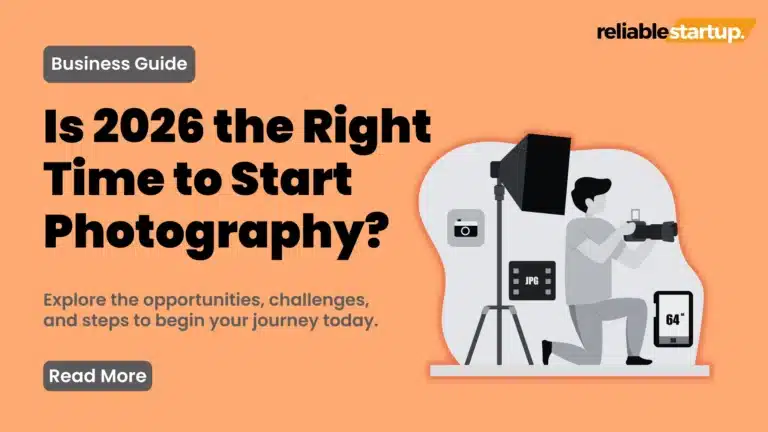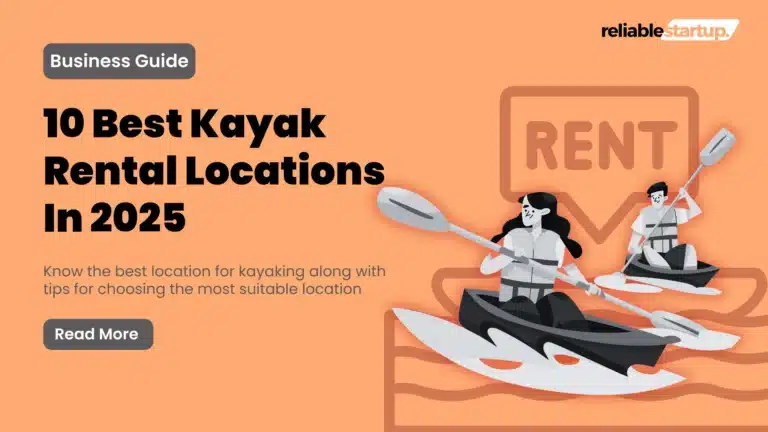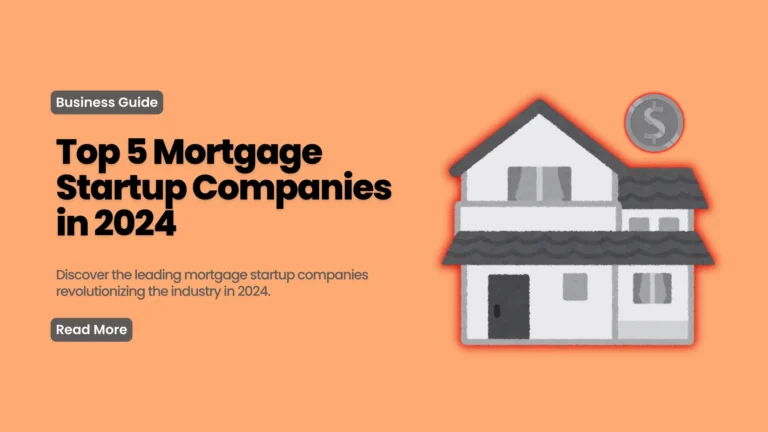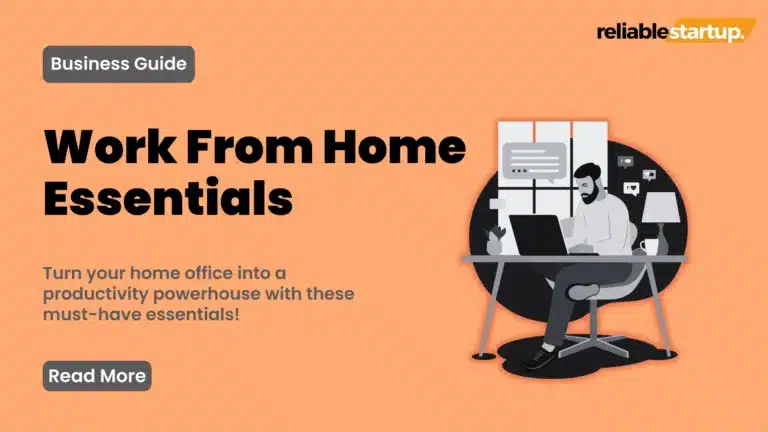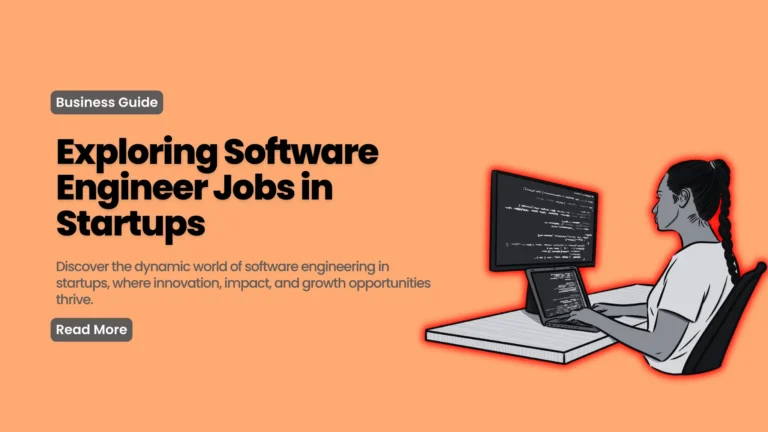How To Launch A SaaS Startup With No Experience?
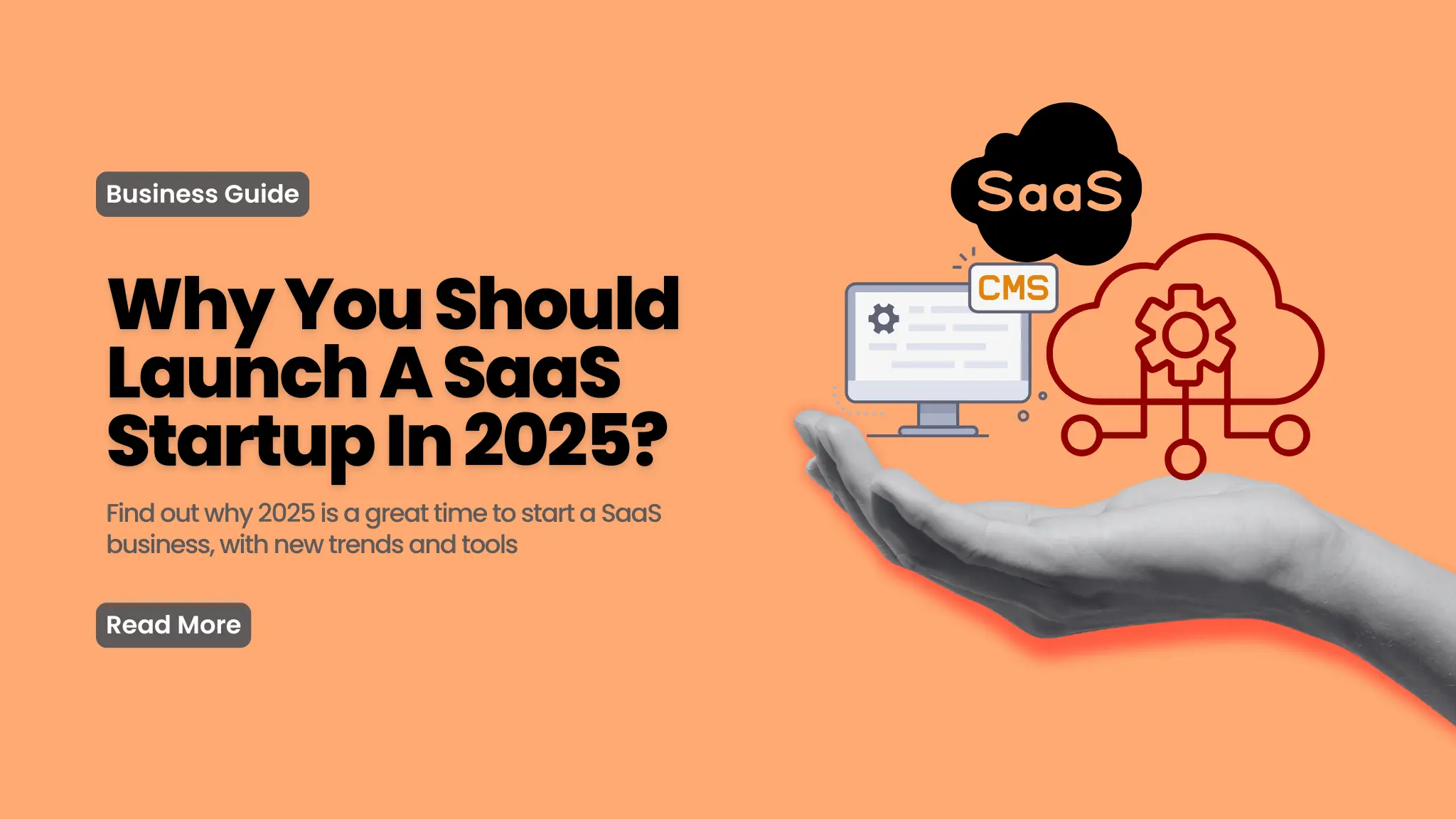
From an era where it took hours to download and install a desired software to the time where it takes just a few minutes to get access to that software. The technical age has grown so fast.
In the last year, the SaaS Cloud was worth of 196 Billion USD and still growing at full pace. This shows that its the best time to start your own SaaS startup.
According to Vena Solutions, The global SaaS market is projected to reach $317.55 billion by the end of 2024, up from $273.55 billion in 2023.
As of 2024, there are over 30,800 SaaS companies worldwide, with the United States hosting approximately 17,000 of them – Demand Sage
Although you have some technical and software development knowledge but dont know:
- Where to start?
- How to start?
- Which saas business is best to start?
But you still ignore these questions and want to take share in the huge market of SaaS.
So dont lose hope. You have come to the right place.
But remember. Starting a SaaS startup is not an easy task. Why?
It requires a lot of trials, tests, and repetitions to make it as you want.
But this comprehensive guide is here to answer all your questions and confusions regarding how to start a SaaS business in detail.
Let’s read on to know more!

What is SaaS?
Let’s start with explaining, what exactly is SaaS and how it works.
SaaS (software as a business) means that users can access the peculiar software just using the web browser or web- based app without the hassle of spending hours to download it.
This type of softwares use its own servers, which is why it’s often called “Web-Based Solution” or Hosted Solution”.
I know you did not get it fullly. Lets see its Charactaristics for better understanding.
Characteristics of SaaS
- Accessibility: SaaS apps are easily available through any internet-enabled device and with a web browser, letting you to work from the comfort of your home.
- Subscription-Based — You need to pay a fee periodically to use SaaS. This may be billed monthly, annually, or per usage.
- Latest Updates: The service provider will be responsible for updates and other necessary maintenance. You’ll always get the access to latest features on time.
- Scalability: SaaS solutions can evolve with your business. It can add more features or users without tearing apart your setup.
- Multi-Tenancy: Multiple clients use the same app(pub). System keeps their data segregated and secure, keeping every customer safe and anonymous.
Benefits for Businesses
- Cost-Effectiveness: You can avoid costly hardware and reduce the software costs (SaaS can save up to 70%).
- Flexibility: In SaaS, companies can control their usage accordingly. This allows them to respond quickly without massive spending.
- SaaS apps are accessible: Staff can log in from anywhere, making remote working and collaboration far easier.
What is Saas Growth Rates In 2025?
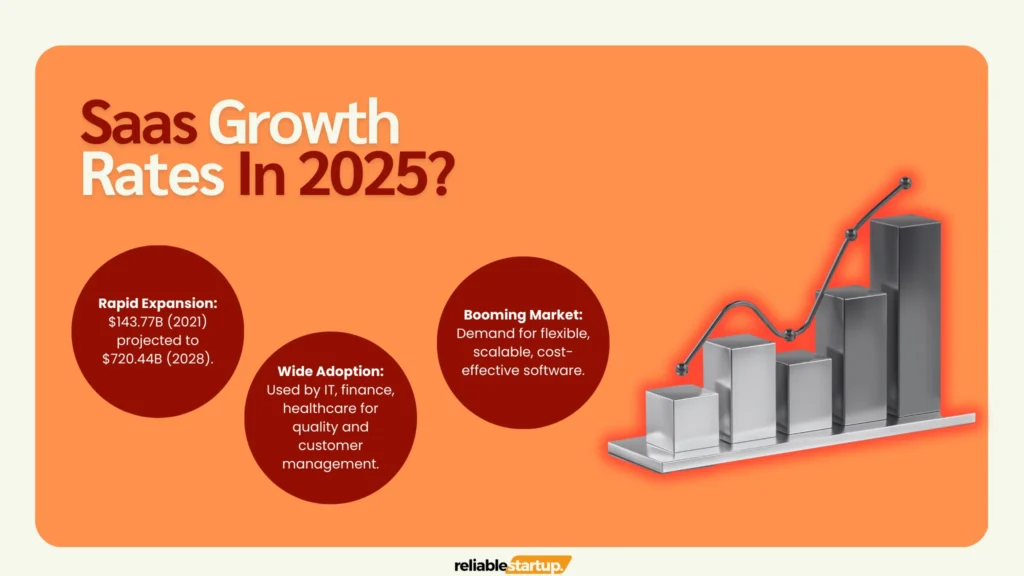
The SaaS market is booming this year because people are more interested in flexible, scalable, and cost-effective cloud software than ever.
This exponential growth resulted due to businesses getting online, employees working from home, and developing instant digital transactions processes.
SaaS startups worldwide raised $10.3 billion in early-stage venture capital funding in the first half of 2024, reflecting a 20.16% year-over-year decrease – Backlinko
Salesforce, Microsoft, Adobe (Creative Cloud), Google, and Oracle are among the few big names using SaaS business models.
Companies in IT, banking and finance, the healthcare industry, and medical centers use SaaS solutions more often—for quality improvement and customer relationships management ,etc.
Businesses love SaaS for its subscription-based, user-friendly approach that scales with your company.
How To Initiate SaaS Startup Ideas?
When you initiate a SaaS Startup Idea, there should be some key factors that need proper consideration for your idea to be successful.
All you have to do is:
Research the Market and Competitors
The very first move towards your SaaS startup idea is to get to know about the needs in the market.
Research the latest trends and explore new needs for making research market gaps.
Look for the weak points of your competitors and to use them in your solution.
Tools like Google Trends, industry reports, and competitor analysis platforms will give you a good idea of how the market works.
Creating Persona
Considering your target demographic is very important in offering a product people desire.
Create more detailed buyer personas about your potential buyers’ demographics, behavior, and preferences.
Survey them, interview them, or search social platforms to find out their problems.
This direct feedback will allow you to customize your SaaS startup ideas to target pain points and deliver real value.
Monetization strategies and Scalability
Successfully scaling your SaaS startup ideas ensures your infrastructure scales and software expands to allow more users.
Use the Cloud and Microservices for Scalability. Make a solid monetization plan that aligns with your business goals as well.
The most popular are subscriptions and freemium price models with paid add-ons (different levels of pricing).
Consider what option will be best for the target customer you are focusing on and your market.
Types of SaaS Solutions
SaaS is vast, targeted to various business models and market needs. Some critical types of
B2B vs B2C
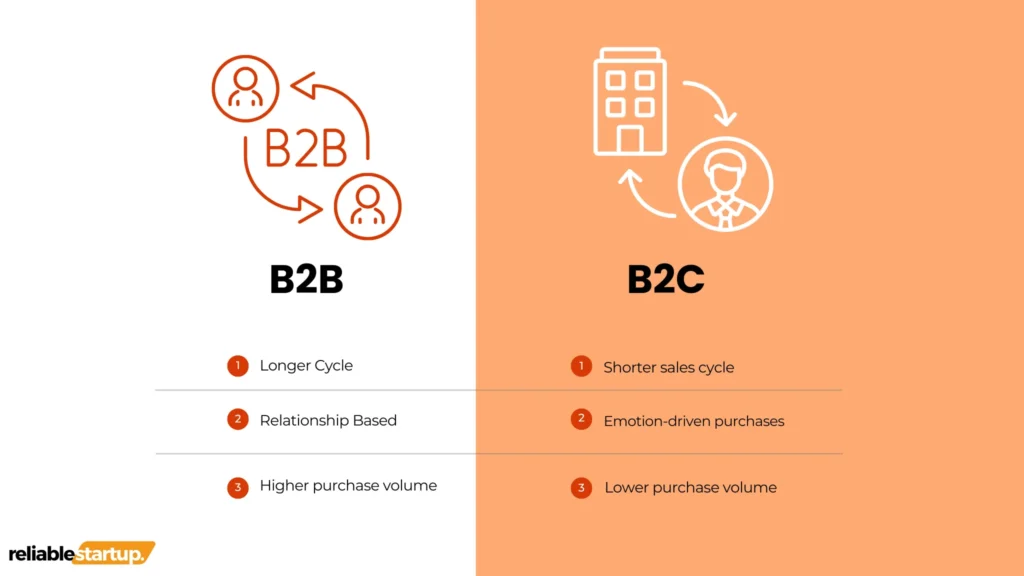
B2B SaaS
These SaaS solutions target the needs of growing businesses. CRM platforms like Salesforce and project management tools like Asana are examples of the type of SaaS b2b Solution.
B2C SaaS
These products make customers’ lives easier. Think about fitness or personal finance apps like Mint or MyFitnessPal or streaming services for movies and TV shows like Netflix.
Micro SaaS
As the name suggests, Micro-SaaS is a small scale SaaS, deals with solving simple and specific problems in particular niche markets.
These solutions are usually created and supported by teams or a single developer or entrepreneur.
Micro SaaS products can be highly profitable due to their low overhead costs and targeted approach.
They appeal to non-tech founders because they often require less technical expertise and investment than more significant SaaS ventures.
Examples include tools for specific tasks like e-mail marketing automation, niche project management, or specialized analytics.
Niche vs. Broad Market Solutions
Niche Market Solutions
These types of SaaS products cover a specific market segment with unique needs.
Focused on a niche, businesses can offer highly specialized features and services tailored to businesses.
This approach can lead to strong customer loyalty.
Examples include software for veterinary clinics, tools for real estate agents, or platforms for freelance writers.
Broad Market Solutions
These aim to serve a wide range of users across various industries.
They offer more generalized features that can be adapted to different use cases.
While targeting a broad market can lead to higher potential user numbers, it also means facing more competition and the challenge of meeting diverse needs.
Examples include general project management tools, cloud storage services, and communication platforms.
Exploring Specific SaaS Startup Ideas
Micro SaaS Ideas for Non-Tech Founders
These small-scale SaaS businesses aim at narrow market segments, making them more promising and lucrative.
Here are some promising micro SaaS ideas:
- Freelancer Tools: The software should assist freelancers in tracking the projects they are involved in or even help track billing.
- Local Business Solutions: Design small business applications, such as an appointment booking utility for salons, or a stock control utility for small shops.
- Healthcare Management: This sector targets small clinics or even single practitioners with specific apparatus, such as patient records, appointments, and telemedicine.
- Education and E-Learning: Create infrastructures that allow shared and online assistance in use of resources. Such applications can be useful for educators, tutors, and small educational institutions willing to step up their online delivery.
- Creative Professional Software: Design professional softwares used to support the design process, content development or portfolio. It can be handy for designers, writers, and artists as individuals require certain tools to present their products conveniently and track tasks.
- Personal Finance Management: Create apps that assist people in keeping records of their spending, financial USEC obligations, or preparing budgets. These tools could provide significant information and assist users in attaining their financial objectives.
- Event Planning Tools: Develop a system that helps organize an event, from managing the guest list and arranging vendors to receiving and tracking responders. This will benefit those planning events in their place of business and private events.
- Niche Marketplaces: Create marketplaces focusing on narrow product verticals, including arts and crafts products, recycled products, or food specialities. These marketplaces can be designed and built to target specific niches and create customer loyalty tax.
B2B SaaS Startup Ideas You Can Go For

The B2B SaaS space is currently full of opportunities for growth solutions, which will enable organizational improvements and optimizations.
Here are some promising B2B SaaS startup ideas you can launch today:
- Customer Relationship Management (CRM) Software: Design solutions for some CRM fields of specialization, including area, medical, or retail. These CRMs can make available elements that pertain to the specific character of the industry.
- Project Management Tools: Develop an interface that works with the tools people already like and use but don’t want to migrate from, such as Slack or Trello.
- HR and Recruitment Platforms: Create a tool that helps with job finding, posting, tracking candidates, evaluation, and hiring. The tool should use logical features to help match candidates to jobs based on skill and experience in the field.
- Financial Management Software: Provide a complete financial package that involves budgeting, estimating, recording expenditures, and presenting your financial position. This may be especially beneficial for small—to midsize organizations that demand potent financial management.
- Supply Chain Management Solutions: Create an application that will assist companies in being more effective in managing their supply chains. These could include inventory control, order handling, and supplier functions.
- Cybersecurity Solutions: Develop software for creating an online platform that will offer suitable solutions and shields for data and business systems against cyber threats. This could include threat identification, risk analysis, and compliance.
- Marketing Automation Platforms: Develop marketing software, businesses can use to enhance their marketing process. Some of its attributes could include e-mail marketing, social media, sales leads, and business intelligence.
- Customer Support and Helpdesk Software: Create a helpdesk solution compatible with an organization’s existing CRM. This solution can include functionalities like ticketing, live chat, and artificial intelligence to address customer issues.
Significant Challenges and Opportunities in B2B SaaS Startup Ideas
Challenges:
- Prolong Sales Cycles: Closing deals takes time or often get delayed due to the long sales cycles prevailing in B2B markets. Receiving that kind of pressure to close deals will be an uphill task.
- High Customer Expectations: In turn, SaaS businesses anticipate high degrees of customization, availability, and service from their suppliers.
- Intense Competition: The B2B SaaS market remains saturated, and stiff competition exists between long-standing competitors and new entrants.
Opportunities:
- Niche Markets: The B2B markets are vast, and investigating any particular segments reveals that many lack appropriate solutions. It, therefore, means that when one can identify these niches, they can fetch a number of suitable opportunities.
- Integration Capabilities: Currently, organizations work with one tool and employ another, allowing SaaS products to operate harmoniously with others.
- Data-Driven Insights: Easy access to detailed analytics and reporting suggests improvements to business decisions and overall organizational performance.
Strategies for Kick-Off SaaS Startup Ideas
MVP Development and Iteration
Creating an MVP is one of the most important and practical strategy to validate business ideas. It is a simple version of your product- focused on only one proposition.
A huge mistake many SaaS businesses make is delaying the launch till it’s 100% ready. Hate to break the bubble- but your ideal SaaS product would never be ready.
Having an MVP will help you to gather the real-user feedback to make the required iterations according to the features and design of product.
This way you will be able to build a sustainable product to beat other SaaS products in the market.
To create and test an MVP, follow these steps:
- The first step is to find what the product will solve and the key characteristics required to meet this requirement.
- The second is market research, which would help you identify your audience and their needs.
- Once you have that, sketch out your MVP or create a wireframe of what a user would see and experience.
- Next, the construction of the MVP emphasizes making the product right by focusing on its utility, not aesthetics.
- Release the MVP in a limited sample of early adopters, consisting of surveys and interviews, and use MVP analytics.
Marketing and Lead Generation
Effective Marketing Strategies for SaaS
Following are the effective marketing strategies for your next SaaS Startup Idea:
- Content Marketing: Make content that helps your audience solve problems. This includes blog posts, white papers, e-books, and case studies. Great content turns your brand into an industry expert offering game-changing products.
- SEO (Search Engine Optimization): Optimize your website to be more visible on search engines to have more organic visits. Focus on on-page SEO (content, tags, quality) and off-page SEO (backlinks social signals).
- Email Marketing: Start email campaigns to get leads and keep customers. Send personal emails to help new users start, give product updates, or offer special deals.
- Social media marketing: Find ways to talk to your audience on social media. Share content and use ads to reach potential customers. Ask your customers to refer your product to their network by offering perks like discounts or free months of service.
- Freemium Model: Start with a basic version of your product with fewer features. This helps people see how good your products are so they’re more likely to buy the full package.
- Paid Advertising: Use PPC (Pay Per Click) on Google ads and social media to bring visitors to your website.
- Share Customer Experience: Share your customers’ stories to build trust and grow your business.
Introduction to Lead Generation Techniques
Lead generation is a process that transforms prospects into a group, who show interest in your company’s product or service.
Let’s see the steps to do this efficaciously:
- Landing Pages: Create customized pages that feature welcome bonuses and have definite calls to action in order to convert visitors into leads.
- Lead Magnets: Share valuable digital content such as eBooks, whitepapers, or webinars to get people’s contact information.
- SEO and Content Marketing: SEO and content can be used to create inbound traffic to content which is equipped with forms and the next steps to collect leads.
- Social Media Advertising:Ttargeted Ads to a specific group of people on social media are a great way to find leads and get them to your landing pages.
- E-mail Campaigns: Craft and distribute an email list for lead generation that includes valuable information and personalized offers.
- Live Chat and Chatbots: Organize live chat with your customers or set up chatbots on your website to communicate with visitors 24/7 and gather their data.
- Webinars and Events: Create webinars and virtual events to draw and involve potential leads.
- A/B Testing: The landing pages, e-mails, and ads you keep changing keep converting more and more people to your site.
Winning Strategies for B2B SaaS Lead Generation Excellence
Attracting and converting leads effectively for your business always ask for extra mile efforts.
Here are some B2B Saas Lead Generation best practices to consider:
Make Your Landing Pages Better
- Clear Value Statement: Tell people how your product helps them.
- Proof from Others: Show what happy customers say to gain trust.
- Works on Phones: Make sure your pages look appealing on mobile devices.
- Strong Action Buttons: Add eye-catching buttons that make people die to click.
Enhance Your Lead Forms
- Simplicity: Make forms brief and ask for must-have details.
- Eye-Catching Design: Use a neat and appealing layout to grab attention.
- Progressive Profiling: Gather more info over time instead of all at once.
Produce High-Quality Content
- Hit the mark and bring value: Create content that tackles your audience’s problems and captures their interest.
- Freebies that work: Give away top-notch stuff like eBooks, whitepapers, or templates to get people’s contact details.
- SEO smarts: Make sure your content plays nice with search engines to pull in organic traffic.
Jump on Live Chat
- Quick help: Be there right away for visitors, which can turn them into leads.
- Info gathering: Use chatbots to learn about what visitors need and like.
Launch Focused Ads
- Lead Generation Ads: Facebook and Google offer platforms to run ads that aim to capture leads.
- A/B Testing: Keep testing different ad creatives and landing pages to determine what performs best.
Make the Most of Social Media
- Engagement: Talk to your audience on social media platforms.
- Content Sharing: Post helpful content and use social media to send people to your lead generation pages.
Ask for Good Reviews
- Customer Feedback: Ask happy customers to write reviews.
- Talk Back to Reviews: Reply to good and bad reviews to show you care about customers’ opinions.
Use SEO Tactics
- Keyword Research: Find and use words that matter to your SaaS Startup Ideas.
- On-Page SEO: Make your website’s content and structure better to rank higher in search results.
Give Free Trials or Demos
- Hands-On Experience: Let potential customers test your product or service before they commit.
- Follow-Up: Use the trial period to collect feedback and reach out with customized offers.
Use E-mail Marketing
- Segmentation: Split your e-mail list to send focused messages.
- PersonalizationPersonalization: Tailor your e-mails to meet the specific needs and interests of your leads.
Financial Considerations for SaaS Startup Ideas
Getting Money for Your SaaS Startup Ideas
If you are at the stage where you need a funding for your SaaS Startup, you have a couple of options to consider.
Every option has pros and cons.
You could go with Bootstrap, which means using your own money or the cash your business makes to keep things going.
This way you also don’t have to answer to investors and will out in the air and debt free. Of course, it isn’t all simple.
If you’re running out of capital or it’s very less, bootstrapping can be costly for your pocket, and it can also be a hindrance in the growth of your business.
In a classical Angel model, angels are people who invest their own money in return for shares or debt in a company and can be converted into shares.
Most of these investors are usually very smart people with experience and contacts that can help your startup to grow fast.
The disadvantage is that you have to provide equity and control, possibly ceding sizeable portions of the company.
Also, it is very time-consuming to find the right angel investor.
Unlike banks and other conventional forms of finance, venture capital, or VC, as commonly called, gets its money from companies that have their main business providing funds to new and growing companies.
VCs can provide you with large sums of money, not the same as investment money, that will help you grow faster and allow you to expand.
They also provide information on market positioning and contact details of individuals in your field.
But this comes at a cost – you probably lose the full company’s control since VCs impact on the decisions you make for your company.
Top 5 SaaS Accounting Software Solutions for Small Businesses

The use of accounting software has a major influence on SaaS startup ideas.
It assists in managing money better, conforming to accounting standards and knowing how well they perform.
Here’s a list of the five best SaaS accounting softwares for small companies:
QuickBooks Online
This software has a powerful arsenal and can expand your business.
You have access to all the accounting concepts, such as how to charge your customers, manage expenditures for your business and generate reports on your money.
It also integrates with many other applications, which fundamentally makes it suitable for expanding organisations.
Xero
This program works best when identifying an income and allows number of persons to use it irrespective of a chosen plan.
You get a view of your data to view and analyze, which you can probably alter to meet your requirements.
It also integrates with many other apps, so it’s quite useful for businesses looking at their accounts.
FreshBooks
We recommend this software because it is simple and unique in billing and managing clients.
It has functions such as time tracking and expense management that suit freelancers and small businesses.
Zoho Books
Several features make users appreciate Zoho Books: the easy-to-navigate user interface and its many functions.
It implies inventory control, project control and the automated procedures used in the construction industry.
It is considered cost-friendly for small businesses looking for an accounting solution that fits all categories.
Wave Accounting
Wave offers one free-of-charge service pack that may include invoicing, receipt scanning, and expense tracking features.
It is suitable for small businesses and freelance workers who require simple accounting operations that will not cost them money.
Future Trends in the SaaS Industry
Latest Technologies and Creations
New technologies and fresh ideas like AI, machine learning, and automation greatly impact the SaaS scene.
AI and machine learning allow SaaS apps to offer more custom services, which boosts user experience and makes things run smoother.
For example, AI-powered analytics can dig deeper into how customers act, helping businesses shape their products better.
Conversely, automation makes routine jobs easier, cuts down on mistakes, and frees up people to work on bigger-picture stuff.
This doesn’t just make work more productive; it also means companies can grow and develop new ideas faster.
SaaS startups have a bright future with these technologies leading the way.
We expect AI-powered SaaS solutions to boom, offering top-notch data analysis, proactive maintenance, and smart automation.
These breakthroughs will result in software that adapts and responds better, guessing what users need and fine-tuning performance.
As this tech grows, SaaS startups that use it will be in a good spot to top the market and spark the next big shift in digital tech.
92% of business leaders are either planning or likely to purchase AI-powered software in 2024, indicating a significant trend towards integrating AI into SaaS solutions according to Vena Solutions.
Sustainable Business Practices
Sustainability is increasingly influencing SaaS development as businesses and consumers prioritize green practices.
Sustainable business methods help reduce environmental effects, boost brand image, draw in green-minded customers, and can result in increased savings over time.
SaaS companies must include sustainability in their development stages to stay competitive and responsible in today’s market.
To create an eco-friendly SaaS business, you can implement several plans. Start by improving energy use.
Make your data centers work better and use clean power sources.
Next, use green coding methods to ensure your software runs well and uses fewer resources. Then, let people work from home.
This reduces driving and the need for office space, which helps the environment. Also, think about buying from suppliers who care about the earth.
Lastly, make being green a big part of your company.
Get your workers to pick up eco-friendly habits to make the efforts worth of trying.

